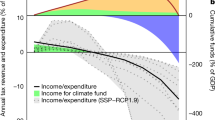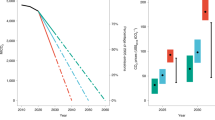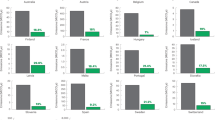Abstract
It is unclear how much carbon should be stored in temporary and risky offsets to compensate one ton of CO2 emissions. Here we cast the social value of an offset (SVO), measured in terms of economic damages avoided, as a well-defined fraction of the social cost of carbon reflecting offset duration, and risks of non-additionality and failure. The SVO reflects the value of temporary storage, and overcomes shortcomings in the climate science and economics of previous contributions1,2,3,4. The SVO is policy relevant. An efficient net-zero policy will consist of offsets if their SVO/cost ratio exceeds the benefit/cost ratio of alternatives. The SVO yields an indicator of the equivalence of offsets to permanent carbon storage measured by the ratio of the SVO to the social cost of carbon. We provide a matrix of equivalence factors for different risks, permanence and climate scenarios. Estimation yields a rule of thumb: one offset sequestering one ton for 50 years is equivalent to between 0.33 and 0.5 tons permanently locked away. Equivalence offers a means of replacing perpetual offset contracts by simpler, easy to monitor short-term contracts, has applications to carbon life cycle analysis5 and the valuation of carbon debts6, and can be the basis of comparing offsets of different qualities in the voluntary and compliance markets.
This is a preview of subscription content, access via your institution
Access options
Access Nature and 54 other Nature Portfolio journals
Get Nature+, our best-value online-access subscription
$29.99 / 30 days
cancel any time
Subscribe to this journal
Receive 51 print issues and online access
$199.00 per year
only $3.90 per issue
Buy this article
- Purchase on Springer Link
- Instant access to full article PDF
Prices may be subject to local taxes which are calculated during checkout


Similar content being viewed by others
Data availability
The data used to create the figures, and the Excel spreadsheet that underpins the tables, are available at GitHub (https://doi.org/10.5281/zenodo.7848892).
Code availability
The code used to create the figures, and the Excel spreadsheet that underpins the tables, is available at GitHub (https://doi.org/10.5281/zenodo.7848892).
References
Kirschbaum, M. U. F. Temporary carbon sequestration cannot prevent climate change. Mitig. Adapt. Strateg. Glob. Change 11, 1151–1164 (2006).
Herzog, H., Caldeira, K. & Reilly, J. An issue of permanence: assessing the effectiveness of temporary carbon storage. Clim. Change 59, 293–310 (2003).
van Kooten, G. C. Biological carbon sequestration and carbon trading re-visited. Clim. Change 95, 449–463 (2009).
Moura Costa, P. & Wilson, C. An equivalence factor between CO avoided emissions and sequestration—description andapplication in forestry. Mitigation Adaptation Strat. Glob. Change 5, 51–60 (2000).
Brandão, M., Kirschbaum, M. U. F., Cowie, A. L. & Hjuler, S. V. Quantifying the climate change effects of bioenergy systems: comparison of 15 impact assessment methods. Glob. Change Biol. Bioenergy 11, 727–743 (2019).
Bednar, J. et al. Operationalizing the net-negative carbon economy. Nature 596, 377–383 (2021).
IPCC Climate Change 2022: Mitigation of Climate Change. Contribution of Working Group III to the Sixth Assessment Report of the IPCC: Summary for Policymakers (Cambridge Univ. Press, 2022).
Groom, B., Palmer, C. & Sileci, L. Carbon emissions reductions from Indonesia’s moratorium on forest concessions are cost-effective yet contribute little to Paris pledges. Proc. Natl Acad. Sci. USA 119, e2102613119 (2022).
Badgley, G. et al. Systematic over-crediting in California’s forest carbon offsets program. Glob. Change Biol. https://doi.org/10.1111/gcb.15943 (2021).
Calel, R., Colmer, J., Dechezlepretre, A. & Glachant, M. Do carbon offsets offset carbon? CESifo working paper 9368 (2021).
West, T. A. P., Borner, J., Sills, E. O. & Kontoleon, A. Overstated carbon emission reductions from voluntary REDD+ projects in the Brazilian Amazon. Proc. Natl Acad. Sci. USA 117, 24188–24194 (2020).
Jayachandran, S. et al. Cash for carbon: a randomized trial of payments for ecosystem services to reduce deforestation. Science 357, 267–273 (2017).
Cherubini, F., Peters, G. P., Berntsen, T., Stroman, A. H. & Hertwich, E. CO2 emissions from biomass combustion for bioenergy: atmospheric decay and contribution to global warming. Glob. Change Biol. Bioenergy 3, 413–426 (2011).
Kendall, A. Time-adjusted global warming potentials for LCA and carbon footprints. Int. J. Life Cycle Assess. 17, 1042–1049 (2012).
Joos, F. et al. Carbon dioxide and climate impulse response functions for the computation of greenhouse gas metrics: a multi-model analysis. Atmos. Chem. Phys. 13, 2793–2825 (2013).
Geoffroy, O. et al. Transient climate response in a two-layer energy-balance model. Part I: Analytical solution and parameter calibration using CMIP5 AOGCM experiments. J. Clim. 26, 1841–1857 (2013).
Watson, R. T. et al. Land Use, Land-Use Change and Forestry (Cambridge Univ. Press, 2000).
Energy Transitions Commission. Mind the Gap: How Carbon Dioxide Removals Must Complement Deep Decarbonisation to Keep 1.5 °C Alive (Energy Transitions Commission, 2022).
Dietz, S. & Venmans, F. The endowment effect, discounting and the environment. J. Environ. Econ. Manag. 97, 67–91 (2019).
Zickfeld, K., MacDougall, A. H. & Matthews, H. D. On the proportionality between global temperature change and cumulative CO2 emissions during periods of net negative CO2 emissions. Environ. Res. Lett. 11 (2016).
Howard, P. H. & Sterner, T. Few and not so far between: a meta-analysis of climate damage estimates. Environ. Resour. Econ. 68, 197–225 (2017).
Burke, M., Hsiang, S. M. & Miguel, E. Global non-linear effect of temperature on economic production. Nature 527, 235–239 (2015).
Korhonen, R., Pingoud, K., Savolainen, I. & Matthews, R. The role of carbon sequestration and the tonne-year approach in fulfilling the objective of climate convention. Environ. Sci. Policy 5, 429–441 (2002).
Poorter, L. et al. Multidimensional tropical forest recovery. Science 374, 1370–1376 (2021).
Fearnside, P. M., Lashof, D. & Moura-Costa, P. Accounting for time in mitigating global warming through land-use change and forestry. Mitig. Adapt. Strateg. Glob. Change 5, 239–270 (2000).
Aldy, J. E., Kotchen, M. J., Stavins, R. N. & Stock, J. H. Keep climate policy focused on the social cost of carbon. Science 373, 850–852 (2021).
Nordhaus, W. D. Revisiting the social cost of carbon. Proc. Natl Acad. Sci. USA 114, 1518–1523 (2017).
Riahi, K. et al. The shared socioeconomic pathways and their energy, land use, and greenhouse gas emissions implications: an overview. Glob. Environ. Change 42, 153–168 (2017).
Golosov, M., Hassler, J., Krusell, P. & Tsyvinski, A. Optimal taxes on fossil fuel in general equilibrium. Econometrica 82, 41–88 (2014).
Traeger, C. Ace—Analytic Climate Economy (CESIFO, 2021).
Badgley, G. et al. California’s forest carbon offsets buffer pool is severely undercapitalized. Front. For. Glob. Change 5, 1–28 (2022).
Buffer Guidelines (FCPF, 2020).
Meschi, P.-X. & Metais, E. Too big to learn: the effects of major acquisition failures on subsequent acquisition divestment. Br. J. Manag. 26, 408–423 (2015).
Bekaert, G., Harvey, C. R., Lundblad, C. T. & Siegel, S. Political risk and international valuation. J. Corp. Finance 37, 1–23 (2016).
Simonet, G. et al. REDD+ Projects in 2014: an Overview Based on a New Database and Typology (Information and Debate Series 32.2.1, Les Cahiers de la Chaire Economie du Climat Information, Paris-Dauphine University, 2015).
Guizar-Coutino, A., Jones, J. P., Balmford, A., Carmenta, R. & Coomes, D. A. A global evaluation of the effectiveness of voluntary REDD+ projects at reducing deforestation and degradation in the moist tropics. Conserv. Biol. https://doi.org/10.1111/cobi.13970 (2022).
Cames, M. et al. How Additional Is the Clean Development Mechanism? Analysis of the Application of Current Tools and Proposed Alternatives (DG Clima, 2016).
Acknowledgements
For helpful comments, we thank the participants of the following conferences in 2022: European Association of Environmental and Resource Economists, European Economic Association, Biodiversity and Economics for Conservation, American Association of Environmental and Resource Economics, UK Network of Environmental Economists, Sustainable Resource Use and Economic Dynamics and the European Society for Benefit Cost Analysis. For helpful comments, we also thank the participants of the San Francisco Federal Reserve Virtual Climate seminar and the Banque de France seminar on biodiversity and nature. We thank A. Balmford, S. Dietz and T Swinfield for very helpful comments on an early draft. B.G. thanks Dragon Capital for financing the Dragon Capital Chair in Biodiversity Economics. Any remaining errors are our own. Both B.G. and F.V. acknowledge financial support from the Grantham Research Institute on Climate Change and the Environment at the London School of Economics and the Economic and Social Research Council Centre for Climate Change Economics and Policy through Economic and Social Research Council grant reference ES/R009708/1. B.G. and F.V. acknowledge financial support from the UK Research and Innovation–Natural Environment Research Council BIOADD project (reference NE/X002292/1).
Author information
Authors and Affiliations
Contributions
F.V. and B.G. contributed 75% and 25% to the theory and 25% and 75% to the writing, respectively. On all other aspects, the contribution was equal.
Corresponding authors
Ethics declarations
Competing interests
The authors declare no competing interests.
Peer review
Peer review information
Nature thanks Kenneth Gillingham and Wilfried Rickels for their contribution to the peer review of this work. Peer reviewer reports are available.
Additional information
Publisher’s note Springer Nature remains neutral with regard to jurisdictional claims in published maps and institutional affiliations.
Supplementary information
Supplementary Information
Supplementary Sections 1–10, including Supplementary Figs. 1–4, Tables 1–4 and References.
Rights and permissions
Springer Nature or its licensor (e.g. a society or other partner) holds exclusive rights to this article under a publishing agreement with the author(s) or other rightsholder(s); author self-archiving of the accepted manuscript version of this article is solely governed by the terms of such publishing agreement and applicable law.
About this article
Cite this article
Groom, B., Venmans, F. The social value of offsets. Nature 619, 768–773 (2023). https://doi.org/10.1038/s41586-023-06153-x
Received:
Accepted:
Published:
Issue Date:
DOI: https://doi.org/10.1038/s41586-023-06153-x
This article is cited by
-
Strong transparency required for carbon credit mechanisms
Nature Sustainability (2024)
-
Evaluating metrics for quantifying the climate-change effects of land-based carbon fluxes
The International Journal of Life Cycle Assessment (2024)
-
Realizing the social value of impermanent carbon credits
Nature Climate Change (2023)
Comments
By submitting a comment you agree to abide by our Terms and Community Guidelines. If you find something abusive or that does not comply with our terms or guidelines please flag it as inappropriate.



